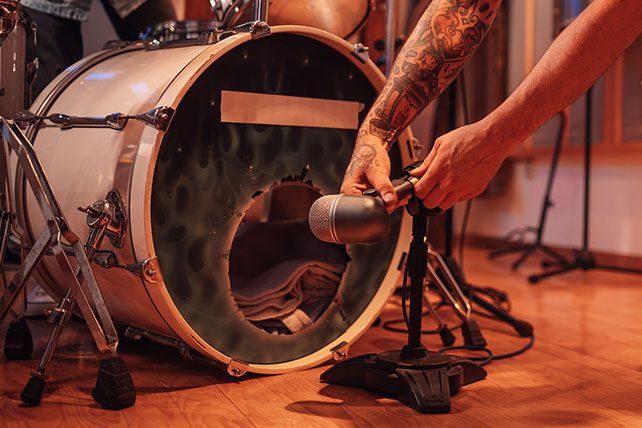Equalization
Kick
Generally, I roll off 600-800 Hz about 6-10 db and boost a tiny little 3.5 k for some snap (if it’s needed). You may have to noodle around with 2 k a bit to keep the punch, but lose the harshness.
Snare
I usually cut 1 k about 3 db and roll off anything under 600 Hz using the high pass filter, in the mids only. Then I select the 80 Hz or 100 Hz shelf, if it’s available.
Toms
Very similar to the bass drum settings, only you have to cut the low end to cut down on the sustain of the tom, especially if the drummer doesn’t use any muffling. If the low end cut isn’t enough and the toms are out of control, I insert a gate compressor and set the gate at it’s fastest attack with the release point sounding as natural as possible (just like the drum sustain sounds to the drummer), and I compress it about 3:1.
Overheads, Hi-Hat
Generally, I roll off anything below 2 k using the high pass filter or just turning the mids and low EQ’s all the way down, and then I select 4 k or 5 k and boost it 3 db-6 db. I also select the 80 Hz-100 Hz shelf. This works if you want to get the nice high end of the cymbals only, but sometimes I open up the mids a bit if I need to hear some ambience of the toms in these channels too, like if the drummer is using brushes, or Pro Mark Hot Rod type multi dowel sticks. In addition to the above, I have also had success using ONLY a kick mic, and ONE overhead if mics or channels are limited.
RELATED: Why Are We Spending so Much Money on Wireless Microphones?
Another successful action for me, (but only in venues with carpeted stages) has been to lay a Shure SM-57 on the floor on the beater head side of the bass drum, under the snare, and then used ONE overhead. You’ll be amazed how well this works. Don’t be afraid to move the mics around and listen to see what sounds best to you. Keep in mind that you are amplifying the sound of the drum kit that has been made available to you. If the kit already sounds bad, you will just end up with a LOUDER bad sounding kit. On the other hand, radical EQ’ing can really make up for a lot and “create” a good sounding drum kit.
The key to getting a good drum mix is experimentation with the available microphones and various positions. Take the time during rehearsal to implement different configurations and find the one that works for best for you. Experimentation can be fun, and the sound can be surprising; nonetheless, I hope that these suggestions for microphones in worship inevitably provide you with better results.

